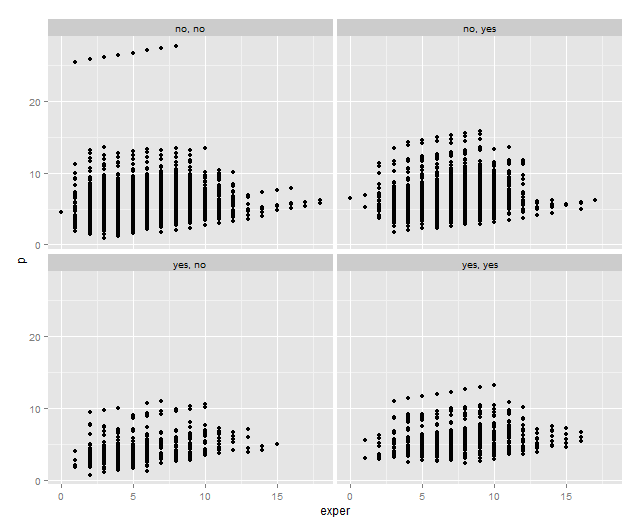Similar to @mtoto, I am also not familiar with either library(plm) or library(pglm). But the predict method for plm is available, it's just not exported. Edit: For models produced by plm::plm(), there is a predict method available since plm CRAN release version 2.6-2.
pglm does not have a predict method.
R> methods(class= "plm")
[1] ercomp fixef has.intercept model.matrix pFtest plmtest plot pmodel.response
[9] pooltest predict residuals summary vcovBK vcovHC vcovSCC
R> methods(class= "pglm")
no methods found
Of note, I do not understand why you are using a Poisson model for the wage data. It's clearly not a Poisson distribution since it takes non-integer values (below). You could try a negative binomial if you wish, though I'm not sure that's available with random effects. But you could use MASS::glm.nb for instance.
> quantile(Unions$wage, seq(0,1,.1))
0% 10% 20% 30% 40% 50% 60% 70% 80% 90% 100%
0.02790139 2.87570334 3.54965422 4.14864865 4.71605855 5.31824370 6.01422463 6.87414349 7.88514525 9.59904809 57.50431282
Solution 1: use plm
punions$p <- predict(fit1, punions)
ggplot(punions, aes(x=exper, y=p)) +
geom_point() +
facet_wrap(rural ~ married)
Solution 2 - lme4
Alternatively, you can get similar fits from the lme4 package, which does have a predict method defined:
library(lme4)
Unions$id <- factor(Unions$id)
fit3 <- lmer(wage ~ exper + rural + married + (1|id), data= Unions)
# not run:
fit4 <- glmer(wage ~ exper + rural + married + (1|id), data= Unions, family= poisson(link= "log"))
R> fit1$coefficients
(Intercept) exper ruralyes marriedyes
3.7467469 0.3088949 -0.2442846 0.4781113
R> fixef(fit3)
(Intercept) exper ruralyes marriedyes
3.7150302 0.3134898 -0.1950361 0.4592975
I haven't run the poisson models because it's clearly incorrectly specified. You could do some sort of variable transformation to handle it or perhaps a negative binomial. In any case, let's finish the example:
# this has RE for individuals, so you do see dispersion based on the RE
Unions$p <- predict(fit3, Unions)
ggplot(Unions, aes(x=exper, y=p)) +
geom_point() +
facet_wrap(rural ~ married)
![enter image description here]()

